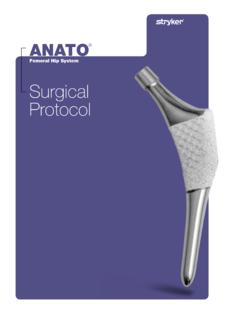Transcription of Trident Tritaniu m Ace tabular System Surgical …
1 Trident Tritanium acetabular SystemSurgical ProtocolSizes 74 80mm1 Trident Tritanium Acet abular SystemSurgical protocol This publication sets forth detailed recommended procedures for using Stryker Orthopaedics devices and instruments. It offers guidance that you should heed, but, aswith any such technical guide, each surgeon must consider the particular needs of each patient and make appropriate adjustments when and as required. See packageinsert for warnings, precautions, adverse effects and other essential product for TridentPolyethylene Insert with Metal orCeramic Head Painful, disabling joint disease of the hipresulting from: degenerative arthritis,rheumatoid arthritis, post-traumaticarthritis or late stage avascular necrosis.
2 Revision of previous unsuccessfulfemoral head replacement, cuparthroplasty or other procedure. Clinical management problems wherearthrodesis or alternative reconstructivetechniques are less likely to achievesatisfactory results. Where bone stock is of poor quality orinadequate for other reconstructivetechniques as indicated by deficiencies of the and PrecautionsSee package insert for warnings,precautions, adverse effects and otheressential product 74 80mmContraindications for TridentPolyethylene Insert with Metal or Ceramic Head Any active or suspected latent infectionin or about the hip joint.
3 Any mental or neuromuscular disorderwhich would create an unacceptable riskof prosthesis instability, prosthesisfixation failure, or complications inpost-operative care. Bone stock compromised by disease,infection or prior implantation whichcannot provide adequate support and/or fixation to the prosthesis. Skeletal Trident Tritanium acetabular System provides surgeonswith a highly porous ingrowth surface. The Trident Tritanium acetabular System hemispherical shellsare manufactured from Commercially Pure Titanium.
4 The Trident Tritanium shells utilize the patented1 Innerchangelocking mechanism. This unique locking mechanism helpsprovide a secure interface between the polyethylene insert andshell. The Large Size shells are available in sizes 74mm-80mm,and offer the option of X3 or Crossfire polyethylene to Table 1for insert and shell compatibility and Trident Polyethylene Inserts are designed to lock into theshell by means of a circumferential ring that engages the shell smating groove. Rotational stability may be achieved when theshell s anti-rotational barbs interlock with the insert s Trident Tritanium acetabular System utilizes theCuttingEdgeTotal Hip acetabular Instrumentation.
5 This surgicaltechnique is a guide to preparing the acetabulum for the TridentTritanium Hemispherical acetabular TritaniumAcetabular ShellX3 PolyethyleneInsert and Crossfire PolyethyleneInsert LFIT IonImplanted CoCrFemoral HeadAluminaFemoral HeadBiolox deltaFemoral HeadTrident Tritanium acetabular SystemSurgical protocol Sizes 74 80mm3 Table 1: Compatibility TableAnatomicFemoral HeadsFemoral , 76, 78, 80J44mm40mm36mm32mm28mm26mm22mmTrident Tritanium Hemispherical ShellLiner Alpha CodeShell Size, Liner Alpha Code, and Liner Thickness (mm)Femoral Head, X3 Liner and Cup Compatibility Chart**Available in X3 only and 0 Tritanium Hemispherical ShellTridentTrident Tritanium TridentEccentricTridentTrident 0 Trident 10 AlphaHemispherical0 , 10 0 , 10 Elevated RimConstrainedConstrainedCodeShell Size (mm)Inserts (mm)Inserts (mm)Inserts (mm)Inserts (mm)
6 Inserts (mm)J74, 76, 78, 80 22, 26, 28, 32, 36, 40**, 44**28, 32, 3628, 32, 3632284 Figure 1 Pre-operative Planning and X-ray EvaluationPre-operative planning and X-ray evaluation aids in theselection of the most favorable implant style and optimal sizefor the patient s hip pathology. Selecting potential implantstyles and sizes can facilitate operating room preparation andassure availability of an appropriate size selection. X-rayevaluation may also help detect anatomic anomalies that couldprevent the intra-operative achievement of the established pre-operative A.
7 D Antonio, Tip: Templating is an important step in the procedurebecause it allows surgeons to estimate the size ofthe implant to be used. Assess the center ofrotation and offset of the hip to determine inferiorlocation of the acetabular component relative tothe tear drop. If a revision of an existing acetabular shell is required, thesurgeon s preferred technique for removing the acetabular shellshould be PreparationThe acetabulum is prepared by the release and removal of softtissue using the surgeon s preferred technique to gain adequateexposure for reaming.
8 Excision of the labrum and osteophytesallows for proper visualization of the bony anatomy, andimproves ease of reaming. Note: Careful identification and removal of osteophytescan help reduce the possibility of bone-to-bone orcomponent-to-bone Orthopaedics Retractors can be utilized to gainacetabular exposure (Figure 1).With the acetabulum exposed, bony defects, can be necessary, bone grafting options may be considered prior to Tritanium acetabular SystemSurgical protocol Sizes 74 80mm5 Spherical ReamingCaution: Only the CuttingEdgeSpherical Reamersshould be used to prepare the acetabulum for theTrident Tritanium acetabular obtain congruity in the reaming process, an optional 45/20 Abduction/Anteversion Alignment Guide can be attached to theCuttingEdgeReamer Handle (Figure 2).
9 The alignment guide,when perpendicular to the long axis of the patient, will orientthe reamer handle at 45 of abduction, thereby placing the axisof the spherical reamer at 45 of inclination (Figure 3). Thereamer handle may then be positioned at 20 of anteversion byaligning the left/right anteversion rod on the alignment guide so that it is parallel to the long axis of the : All external alignment guides depend onknowing the patient is in a lateral decubitis position,therefore acceptable to : Changes in pelvic tilt and pelvic flexion causedby patient positioning on table as well as disease incontralateral hip, spine, and pelvis may impactachievement of 45/20 degree is recommended that initial reaming begin with a CuttingEdgeSpherical Reamer that is 4mm smaller than the templated orgauged size.
10 The reamer is attached to the reamer handle bypushing down and applying a quarter-turn to lock in progresses in 1mm increments until final desired sizingis achieved. Due to the porous nature of the Tritanium coating,the outer diameter may be larger than the size indicated. Thesurgeon must consider this in the acetabular : The amount of interference fit should bedetermined intra-operatively based on the patient'sbone quality. When osteoporotic bone isencountered, it is recommended to under-ream by1mm. When sclerotic bone is encountered, it may bedifficult to fully seat the shell with a 1mminterference fit.









